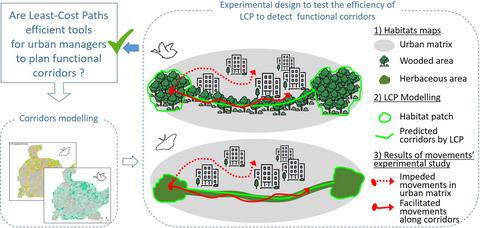当前位置:
X-MOL 学术
›
J. Appl. Ecol.
›
论文详情
Our official English website, www.x-mol.net, welcomes your feedback! (Note: you will need to create a separate account there.)
Least‐cost path analysis for urban greenways planning: A test with moths and birds across two habitats and two cities
Journal of Applied Ecology ( IF 5.7 ) Pub Date : 2020-11-24 , DOI: 10.1111/1365-2664.13800 Manon Balbi 1 , Solène Croci 2 , Eric J. Petit 3 , Alain Butet 1 , Romain Georges 1 , Luc Madec 1 , Jean‐Pierre Caudal 1 , Aude Ernoult 1
中文翻译:

用于城市绿道规划的最小成本路径分析:在两个生境和两个城市的飞蛾和鸟类的测试
更新日期:2020-11-24
Journal of Applied Ecology ( IF 5.7 ) Pub Date : 2020-11-24 , DOI: 10.1111/1365-2664.13800 Manon Balbi 1 , Solène Croci 2 , Eric J. Petit 3 , Alain Butet 1 , Romain Georges 1 , Luc Madec 1 , Jean‐Pierre Caudal 1 , Aude Ernoult 1
Affiliation

|
- One of the major planning tools to respond to urban landscape fragmentation is the development of ecological corridors, that is, interconnected networks of urban green and blue spaces. Least‐cost paths (LCP) appear to be an easy and appropriate resistance‐based modelling method to respond to urban planners’ needs. However, the ecological validation of urban corridors using LCP is rarely performed and needs to be generalized to different species, habitats and cities.
- We developed an experimental design to test the efficiency of LCP predictions to detect highly connecting landscape contexts that facilitate individual movements compared to movements in less connecting landscape contexts. We deliberately assigned LCP analysis parameters based on the scientific literature and expert knowledge to test a method potentially easy to use for urban stakeholders. To extend the validation, we applied our LCP model to two biological taxa with different habitat requirements: grassland‐dwelling moths and forest‐dwelling passerines, and to two medium‐sized cities.
- We used mark–release–recapture (MRR) methods for moths and playback recall protocols for passerines to compare the patterns of individual movement between two contrasted connectivity contexts determined by the presence and absence of modelled LCPs. MRR protocol estimated movement rates between herbaceous patches and the two contrasted connectivity contexts. Playback recall protocol consisted in attracting individuals from wooded patches to the two contrasted connectivity contexts. A movement was considered facilitated, when displacement was rapidly engaged and individuals moved a long distance from their wooded patch.
- Moth and passerine movement patterns differed between the two connectivity contexts: moth recapture rates were higher in highly connecting contexts than in less connecting contexts. For passerine birds, responses to playback recalls were faster and movement distance longer in highly connecting contexts. All results support the hypothesis that both taxa were more prone to move in corridors modelled by LCP.
- Synthesis and applications. The convergence of the results for different biological models and across cities strengthens the relevance of LCP analysis for planning urban greenways and provides guidelines for landscape planners in the development of these corridors to favour the movement and survival of multiple urban species.
中文翻译:

用于城市绿道规划的最小成本路径分析:在两个生境和两个城市的飞蛾和鸟类的测试
- 应对城市景观破碎化的主要规划工具之一是生态走廊的发展,即城市绿色和蓝色空间的互连网络。最低成本路径(LCP)似乎是一种容易且合适的基于阻力的建模方法,可以满足城市规划人员的需求。但是,很少使用LCP对城市走廊进行生态验证,需要将其推广到不同的物种,栖息地和城市。
- 我们开发了一个实验设计,以测试LCP预测的效率,以检测高度连接的景观环境,与在连接较少的景观环境中的运动相比,这些运动有助于个人运动。我们根据科学文献和专家知识故意分配了LCP分析参数,以测试一种可能对城市利益相关者易于使用的方法。为了扩展验证,我们将LCP模型应用于两个具有不同栖息地要求的生物分类单元:草地飞蛾和森林居住的雀形目,以及两个中型城市。
- 我们对飞蛾使用了标记-释放-捕获(MRR)方法,对雀形目使用了回放召回协议,以比较由两个模型化LCP的存在与否所确定的两个相反的连接上下文之间的个体运动模式。MRR协议估计了草本补丁和两个对比的连通性上下文之间的移动速率。回放召回协议包括将人从树木繁茂的地块吸引到两个形成对比的连通性环境中。当人们迅速进行流离失所,并且人们从树木繁茂的地块移开很长一段距离时,人们认为这是一种运动。
- 在两个连通性环境中,蛾和雀形目的移动方式有所不同:在高度连通的环境中,蛾的捕获率高于在较少连通的环境中。对于雀形目鸟类,在高度联系的情况下,对回放记忆的响应更快,移动距离更长。所有结果都支持以下假设:两个分类群都更倾向于在LCP建模的走廊中移动。
- 综合与应用。不同生物模型和整个城市的结果的融合增强了LCP分析与规划城市绿道的相关性,并为景观规划者在开发这些走廊时提供了指导,以支持多种城市物种的移动和生存。



























 京公网安备 11010802027423号
京公网安备 11010802027423号